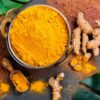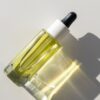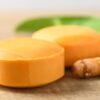Turmeric For Skin: Top Benefits of Turmeric for Healthy Skin
- Posted on
 Taiba Tariq
Taiba Tariq- Categories: Turmeric Skin Care

During turmeric’s most extended history of holistic healing, it has sorted out upset stomachs, fixed colds, and disinfected wounds. It has also encountered acne, resisted sun-damaged skin, bestowed brides with radiant and glowing skin tones, and done a lot that it’s now famous for its diversified health benefits. This article focuses on “TURMERIC FOR SKIN” concerning skin-related infections.
IS TURMERIC BENEFICIAL FOR THE SKIN?
This sunset-colored spice, scientifically known as Curcuma longa, possesses anti-inflammatory, antimicrobial, wound healing, and antioxidant effects that can aid to:
- heal wounds fast
- prevent breakouts
- fight eczema and psoriasis
- lighten fine lines & acne scarring
- remove dark circles under-eye
- boost natural glow
USES OF TURMERIC FOR SKIN
1. TURMERIC FOR GLOWING & RADIANT SKIN
Research and study revealed turmeric’s essential oil in the lubricant or moisturizer preparation could brighten skin within 3-4 weeks with super-satisfying results due to potent antioxidants and anti-inflammatory compounds complementing to heal and bring out the skin’s natural glow and radiance.
You can ditch your toxin-laden expensive cosmetics and use a simple homemade turmeric mask.
How to prepare: DIY GLOWING PASTE
- 1 tablespoon of gram flour
- 2 tablespoons of curd
- Half a teaspoon of turmeric
- Half a teaspoon of honey.
Mix all ingredients well. Apply it to the face and let it stay for 15 minutes before you wash it off. You can apply the same paste to the entire body. If you often suffer from acne, apply the paste to the infected part.
2. TURMERIC AS A SKIN HEALER
Curcumin helps heal wounds by reducing inflammation and oxidation stress.
Clinical studies observed turmeric’s positive effect on new tissue formation and collagen boosting. It is best to apply curcumin as an optimal treatment for skin wounds.
Moreover, it calms down the swelling resulting from wounds and injuries.
Healing turmeric paste
- Mix 2 teaspoons of turmeric powder with lukewarm water or coconut oil until it becomes a thick paste.
- Apply the paste to cleansed wound and cover it with a bandage for a day.
3. TURMERIC CAN REVERSE PSORIASIS & ECZEMA
Psoriasis results from an autoimmune inflammation that causes skin cells to build upon each other, creating scaly patches cracking, and bleeding. The antioxidant and anti-inflammatory enzymes in curcumin can help your psoriasis by swaying the spreading or flaring of skin eruptions, combat cell production, inhibiting the activity of PhK (a protein linked to psoriasis), and reducing skin patches. Further, it can help relieve Eczema (skin problems having deeper roots due to issues with the immune system & toxin accumulation in the body).
The National Psoriasis Foundation says you can use it in supplements or meals. Be sure you use it; the foundation recommends discussing the proper dosage with your health expert.
Both topical and oral curcumin may reverse symptoms of plaque psoriasis in 9–12 weeks.
DIY Overnight topical paste for psoriasis
- Mix a part of turmeric root powder with two parts of water.
- Simmer in a pot until the mixture turns into a paste.
- Let it cool, and apply the paste to the affected area.
- Wrap a piece of bandage around the affected area of your body.
- The very next morning, remove the application and rinse your skin with lukewarm water.
4. TURMERIC FOR FINE LINES & ACNE SCARS
Are you worried about fine lines and acne scars? Don’t panic. The anti-inflammatory content in turmeric can fix your pores and fine lines.
Acne bursts out due to the bacteria named Propionibacterium.
A study suggests curcumin-supplemented lauric acid is effective in combating acne-causing bacteria.
Combine turmeric powder with skin-healthy DIY face packs, such as honey, apple cider vinegar, yogurt, coconut oil, turmeric essential oil, or aloe.
DIY Turmeric face pack for acne scars & fine lines
- Mix one tbsp. Of honey with one tsp of organic turmeric powder.
- Add a few drops of lemon juice.
- Apply the paste to the skin.
- Let it remain for 15 minutes.
- Rinse with lukewarm water.
5. TURMERIC CAN HELP ALLEVIATE SCABIES SYMPTOMS
Scabies is a contagious skin eruption caused by mites, leading to intense itching and a pimple-like skin rash. It is typically treated with a prescription cream and hydrocortisone lotion. Still, a clinical study from India observed that combining turmeric and neem extract is 95 percent effective in curing scabies.
6. TURMERIC FOR HYPERPIGMENTATION & DARK CIRCLES
Ultra Violet rays cause sunburns, skin cancer, fine lines, hyperpigmentation, and wrinkles. But turmeric may help you reverse the clock. The antioxidant in turmeric is free radicals protecting you from pollutants and UV rays affecting your skin’s elasticity. The latest research found that turmeric’s antioxidant contents improved sun damage in rat skin. Curcumin blocks the enzyme elastase attacking your skin’s ability to produce elastin.
DIY Turmeric Overnight Serum
- Blend 5 tbsp of aloe Vera gel with 12 drops of turmeric essential oil and one teaspoon of argan oil.
- Apply to face before bedtime.
- Rinse it in the morning.
- Do an allergy patch test first on the forearm area.
7. CURES VITILIGO & WHITENS COMPLEXION
Vitiligo is a skin disease that is responsible for skin depigmentation. In rare cases, curcumin may escape risks of oxidative stress in skin cells that are blamed for producing melanin. Turmeric is naturally rich in Glutathione, an antioxidant that reduces melanin levels and promotes fairness. So what whitening creams can never do, turmeric can do for you.
RISKS IT MAY HAVE!
- Always consider a small dosage of turmeric for the first time, and see your body’s response before increasing amounts.
- Be careful about the dosage, product type, and how it might react to other medications you take.
- While applied on the skin, it can leave a temporal stain. If you’ve got an allergy issue, direct skin contact can cause irritation, redness, and swelling.
- Always consider a patch test on your forearm area. For this, apply a dime-sized amount and let it stay for two days to ensure you react before using it on your face.
Taiba Tariq
Taiba Tariq is a healthcare nutrition hobbyist, enthusiastic about researching healthcare & skincare news while analyzing the latest and science-backed evidence about nutrition, skin care, and supplements. She wants to help people regain their beauty, health, and well-being through natural means.
all author posts




